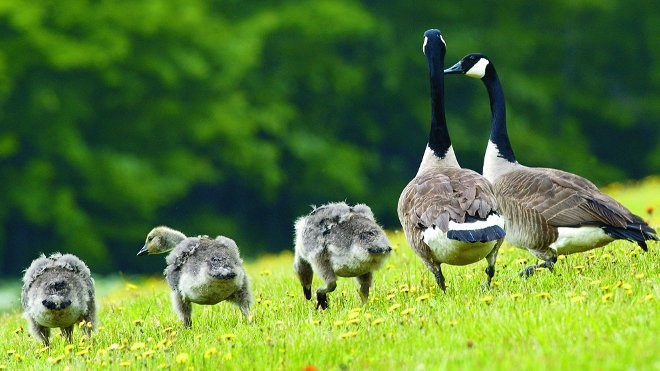With the population of Canada Geese soaring across the country, so, too, is the amount of ... err ... droppings the birds are depositing on open areas in Canadian cities, including Sudbury.
A Minnow Lake resident recently complained to the local Community Action Network about problems in her area.
“We can not even take our pets out for a walk because of all the crap on the street,” the woman wrote to the CAN. “The geese have made their way to Picard Street – Howey/Bellevue is next.”
In response, CAN chair John Lindsay said it's a problem that many people are having with geese and their droppings.
“We have had some success along the park area on Bancroft Drive, but only because the geese cannot land or take off in the limited space between the fence along the waterfront and the hill to the roadway,” Lindsay said. “We have a goose fence at Minnow Lake Place, but the geese can land and take off from the grass area with no problem.”
To address the issue, Greater Sudbury introduced a Geese Management Program several years ago, with a $75,000 budget. And last year, it moved the start date for the program up by two weeks to begin dealing with the geese before they get settled in.
Shannon Dowling, a communications officer with the city, said the program focuses on Bell Park, Grace Hartman Amphitheatre, James Jerome Sports Complex, Nepahwin, Moonlight Beach, Robinson Park.
"Our park staff regularly cleans geese droppings from any of the park sites,” Dowling said. “They'll do raking, they sweep playing fields, raking is done at beaches."
Geese fences – which aim to disrupt the bird's ability to safely land in open areas – have also been installed in some of the areas.
"They act as a deterrent from them actually coming up on the beach area," Dowling said.
Other methods include “hazing” the geese. That involves using noisemakers and dogs to chase away the birds before they settle into an area.
"Basically, they scare the geese away from any of the sites," she said. "And they vary (the methods) so the geese don't get wise ... It's considered one of the most popular, effective and humane geese control methods."
However, the city's program does nothing to address the size of the geese population, which is growing by 10-15 per cent a year, according to a 2013 staff report on the issue. The reason for the increase, in part, is their ability to adapt to environments where humans live.
“Many gravitate to suburban and urban areas where they are not only protected from predators, but also are safe from hunting,” the report said.
Lindsay said the city should consider adopting a method used in Sault Ste. Marie, Mich. – allowing a hunt of areas where the population is getting out of control.
“They actually (shoot) them until the numbers were reduced to the point where this was no longer necessary,” Lindsay said. “I guess the word got around the goose community that this community was not the spot to live or die.
“I personally feel that some of our blue-green algae problems in certain lakes may be related to goose droppings together with increased phosphorus levels, but that is only my opinion, but in any case the droppings do present a health hazard.”
Dowling said, as far as she is aware, there are no plans to consider letting hunters cull the geese.
"The program does not have the capacity to control geese populations,” she said. “The goal is to discourage geese presence at parks and sports fields."
Join Sudbury.com+
- Messages
- Post a Listing
- Your Listings
- Your Profile
- Your Subscriptions
- Your Likes
- Your Business
- Support Local News
- Payment History
Sudbury.com+ members
Already a +member?
Not a +member?
Sign up for a Sudbury.com+ account for instant access to upcoming contests, local offers, auctions and so much more.
